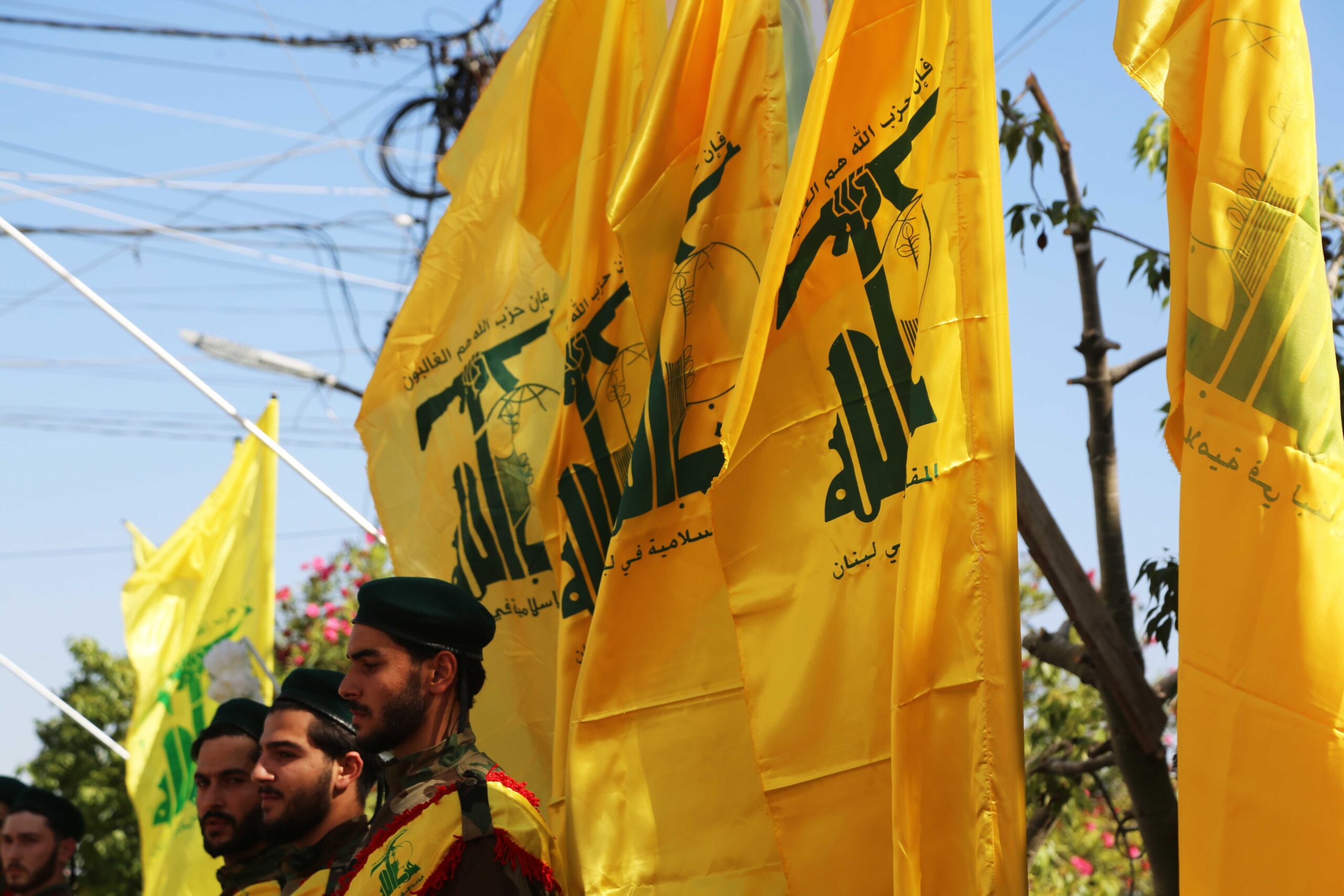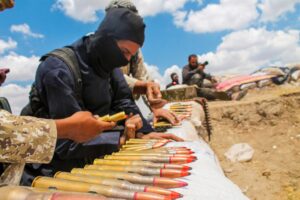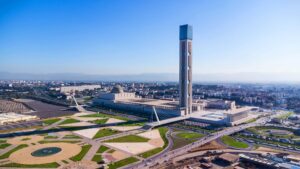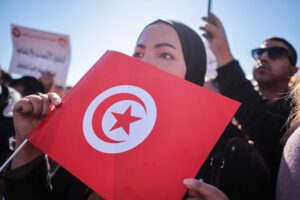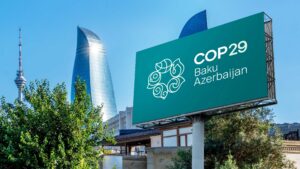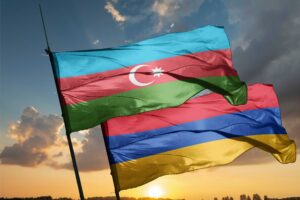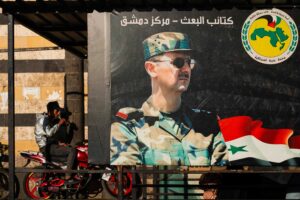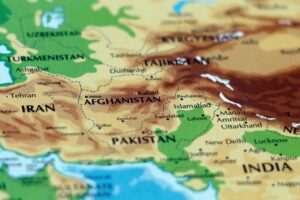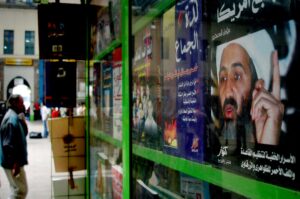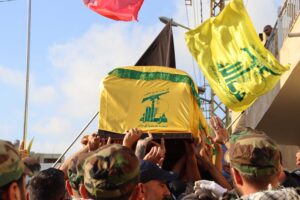It was November 2017. The columns of an ancient temple stood wearily against the persistent sun, which attempted to expose every cavity in the structure’s limestone canvass. Below, a rugged seller displayed his wares to the occasional passer-by, among which were several yellow t-shirts for sale that bore the emblem of Hizbullah – its green Kalashnikov and globe highlighting the group’s avowed commitment to supranational struggle. This discovery came as little surprise; during 1982, it was here in the city of Ba’albek, northern Lebanon, that the ‘Party of God’ was established. Almost since then, interested outsiders, from academic historians to security analysts, have attempted to understand the extent to which pan-Islamic ideas have shaped the core ideology of the party. Several scholars, such as Martin Kramer, argue that these were a genuine part of Hizbullah’s actions. [1] By contrast, historians like Amal Saad-Ghorayeb view pan-Islam as a concept that solely existed in the ‘intellectual realm’ for Hizbullah and was thus never truly implemented. [2]
Pan-Islam
In general terms, pan-Islam is best understood as the ideology that aims for solidarity amongst the umma, or the world community of Muslims, in cultural, economic, and political terms. Nonetheless, it remains vexatious to define as well as to implement. Islām alone is an awkward concept. As the verbal noun of the Arabic root S L M, which connotes ‘to submit’ or ‘to surrender’, the word itself implies that individual action is at the centre of man’s relationship to God.[3] Shahab Ahmed cogently argues that ‘in the first semantic instance, [Islam] is something a person does’.[4] As such, the religion inherently contains variation in belief: each individual follower or believer can choose the manner in which they submit, creating multiple and contradictory interpretations as to how the religion should be practised. This makes the implementation of pan-Islam, an idea that seeks to unite all Muslims, particularly difficult.
Hizbullah
Hizbullah’s rise to power in Lebanon was rapid yet complex. Consequently, for the purposes of clarity, this essay focuses on the period of 1982 to 1992. The group’s foundations were radical, Islamist, and often militant. However, their decision to contest parliamentary elections in 1992, instead of maintaining a wholesale rejection of the government, indicated that Hizbullah was willing to increase its alignment with the status quo in Lebanon.
It is impossible to interrogate the evolution of Hizbullah without acknowledging the influence of Iran. Ruhollah Khomeini and his revolutionary Iran provided a significant source of inspiration for Hizbullah’s members and supporters, while the revolution of 1979 was crucial in revitalising global interest in pan-Islamic ideas, championing the ideal of an Islamic government and calling for the export of the Islamic revolution. As such, pan-Islam as it was understood in the later twentieth century was closely linked to Iran’s interpretation of the concept. Iran’s promotion of pan-Islamic ideas is clear in its constitution of 1979, which states Iran ‘should exert continuous efforts in order to realize the political, economic and cultural unity of the Islamic world’.[5] That Khomeini’s Iran was a source of inspiration for Hizbullah in particular is evident in a photo in al-‘Ahd, the organisation’s newspaper that was set up in 1984. It shows little girls distributing pictures of Khomeini to passing cars during 1985 celebrations in Lebanon of the anniversary of the Iranian revolution.[6]
Methodology
In analysing Hizbullah’s implementation of pan-Islam, this article focuses on its use of rhetoric and imagery. These were, and remain, crucial to Hizbullah’s methods of implementation of their ideology. Hizbullah’s set of ideas focused on the central concept of ‘resistance’; it is no accident that its Open Letter of 1985 is addressed to the ‘oppressed in Lebanon and the world’.[7] As a result, if we follow the thought of Antonio Gramsci, in order to implement their idea of resistance, Hizbullah had to fight a ‘war of position’. Although this term is used in multiple ways by Gramsci, his crucial argument is that a ‘war of position’ would alter the consciousness of the oppressed classes to make them aware of their subjugation, leading to an overthrow of the status quo.[8] With regard to Hizbullah, the oppressed were either the Shi’ites, the Lebanese in general, or the umma, contingent upon the context. Rhetoric from Hizbullah-affiliated religious leaders, and political posters, provided consistent, persuasive messages to the oppressed in an attempt to produce a change of consciousness from the latter. Hizbullah clearly valued this form of implementation; from 1987, it formally created a centralised media production, the Central Information Unit.[9] The focus on Hizbullah’s media as a form of implementation is supported by Dina Matar, Lina Khatib, and Atef Alshaer, who argue that Hizbullah utilised communication strategies – in their case, television and newspapers – to achieve its political goals.[10]
Implementation
Hizbullah’s interpretation of pan-Islamic ideas revolved around the idea of a united Muslim struggle. This was a key tenet of pan-Islam in the later twentieth century, when unity of the umma against neo-colonialism and Zionism was more relevant than a general political union of the Muslims. The creation of Israel in 1948 added a new anti-Zionist ingredient to pan-Islam. In the eyes of many Muslims, the Jews had seized the land of largely Muslim Palestinians, and also threatened the significant Islamic holy site in Jerusalem, the Dome of the Rock, and thus had to be opposed by a united umma. Resistance to neo-colonialism also was a relevant aspect of pan-Islam at the time. The Islamic awakening, aṣ-Ṣaḥwah lʾIslāmiyyah, that had begun in the late 1970s, sought to restore Muslims to their past prosperity, which included preventing the neo-colonialism of the US from further harming the umma. In light of the decline of the economically and politically stagnant USSR, the threat of a hyperpower US was on the horizon. Thus, a united Muslim struggle against this new threat of a unilateral form of American neo-colonialism became an increasingly popular interpretation of pan-Islam. Such an idea was articulated by Khomeini’s revolutionary Iran, which, as explained earlier, was a key influence in late twentieth century pan-Islamic ideas. The 1979 constitution highlights that the failure of the past ‘religious school movements’ was due to the ‘absence of struggles’.[11] This indicates that a united Muslim struggle was a central aspect of pan-Islam at the time.
Through rhetoric Hizbullah implemented the idea of a united Muslim struggle against Zionism. Hizbullah utilised rhetoric which associated Israel with sexual abuse, highlighting the moral depravity of Israel, and thus the threat it represents to the holy site of the Dome of the Rock and its tyrannical treatment of Palestinian Muslims. For instance, throughout sections fifteen to twenty-two of the Open Letter, Israel is rarely discussed without the denomination of a rapist – the ‘Zionist entity that raped Palestine’ is a typical sentence.[12] This was not only the language of Hizbullah’s officials, but also its ordinary members or followers. Consider the example of Khaidiji, a female member of Hizbullah who lived in south Beirut. When discussing her past, she calmly uses the expression ‘rape of Palestine’ when discussing the conflict with Israel – indicating that it was an everyday label among Hizbullah supporters.[13] Hizbullah’s use of this form of rhetoric clearly affected the language of its largely Shi’ite followers; normalising powerful anti-Zionist sentiment, and thus spreading the idea of a Muslim front against their oppressors. Hizbullah utilised posters in an attempt to unite the umma in a struggle against Israel. In this regard, the Dome of the Rock, an Islamic shrine in the old city of Jerusalem, was a consistently used symbol. The Dome was an important holy site for Muslims but was under the control of the Israeli enemy; Israel captured the old city in the Six Day War and briefly hoisted an Israeli flag over the Dome. Thus, it was a powerful image for members of the umma. It was used in a Hizbullah poster from 1984, which articulates a need for the umma to be united against their non-Muslim oppressors. The poster depicts two soldiers, a woman dressed in a hijab, and a Muslim cleric advancing together towards the Dome of the Rock. The writing on the poster reads, ‘Jerusalem… here we come. Every Muslim has to prepare himself to confront Israel… and Jerusalem will ultimately return to Muslims’.[14] The portrayal of numerous different members of society demonstrates that all Muslims, no matter what gender or profession, must be involved in the struggle against their oppressors. Consequently, several images in this poster encouraged a change of consciousness among Muslim onlookers to unite all members of the umma against their Zionist oppressors.

Figure 1: Hizbullah, Poster, 1984, Maasri, Off the Wall, Fig. 3.28.
Shi’ite particularism
Despite these early efforts to carry out the idea of a united Muslim struggle, Hizbullah’s implementation of pan-Islam was undermined by the organisation’s Shi’ite particularism. Ultimately, its chief aim of improving the condition of Shi’ites largely in Lebanese society, but also beyond the borders, sacrificed the pan-Islamic ideal of Sunni-Shi’ite unity. Although often pan-Islamic on the surface, Hizbullah’s rhetoric and imagery contained Shi’ite symbols; resulting in a message of Shi’ite universalism instead of pan Islam. This spoke intimately to Shi’ite observers and listeners but excluded those who were Sunni.
In order to understand why this phenomenon occurred, it is crucial to appreciate the context against which Hizbullah rose up. The party was formed and supported by Shi’ites frustrated at their inferior position in Lebanese society. Despite being the largest sect in Lebanon, the Shi’ites had the least constitutional power. Under the National Charter of 1943, the President had to be Maronite Christian and the Prime-Minister Sunni, while the Shi’ites were only given representation by the lesser role of Speaker of the House. Furthermore, non-Shi’ites intended to maintain their advantage in society via cultural hegemony. Maronite Christians and Sunnis formulated a mode of thinking that aimed to keep the more numerous Shi’ite population in a subordinate position in society. As Roschanack Shaery-Eisenlohr demonstrates, jokes and stereotypes were frequently constructed by Sunnis and Maronites about the inferiority of the Shi’ites and their unworthiness of partaking in the rule of Lebanon.[15] As Shi’ites became increasingly aware of their subordination, their anger at the injustice of their treatment and position in Lebanese society grew. This was exacerbated by the failure of Amal, at the time the more institutionalised Shi’ite representative party in Lebanon, to effectively improve the Shi’ite condition – a revision of the National Charter remained unachieved in the 1980s.[16] Consequently, by taking actions that augmented the position of Shi’ites, Hizbullah could draw the majority of Shi’ite support away from Amal. This led to the ‘Party of God’ articulating a form of Shi’ite universalism, instead of pan Islam.
Shi’ite universalism contradicted pan-Islam, undermining Hizbullah’s aforementioned efforts to implement the latter. The former aims to improve the global condition of the Shi’ites; often realised in calls for the overthrow of a Sunni-dominated regime. By contrast, pan-Islam calls for increased unity among all Muslims, whether Sunni or Shi’ite. Shi’ite universalism undermines pan-Islamic ideas as it causes divisions among Sunnis and Shi’ites instead of encouraging the unity of the two sects. For example, as part of his general argument on the global resurgence of Shi’ism, Seyyed Vali Reza Nasr demonstrates that Khomeini’s revolution in 1979 provided inspiration to Shi’ites in Saudi Arabia. Protests erupted among the Shi’ites against their Sunni rulers in the oil-rich east of the country, to which the Saudi monarchy responded with brutal crackdowns.[17] This was the very opposite of what pan-Islam aimed to achieve; one of its key early champions in South Asia, Muhammad Iqbal, stated in a poem, ‘From the Banks of the Nile/ To the soil of Kashgar/ The Muslims should be united’.[18] The fact that Iqbal desired for all Muslims across the Middle East and South Asia to be united, which included both Sunni and Shi’ite dominated areas such as the Gulf states and Iran respectively, indicates that this key pan-Islamic thinker sought to overcome the doctrinal differences of certain geographical areas. The frequently anti-Sunni consequences of Shi’ite universalism resulted in an undermining of this pan-Islamic aim. Underneath the surface of its audio-visual production, elements of which have been shown to be pan-Islamic, Hizbullah in fact disseminated a message of Shi’ite universalism. Consider a poster from 1985. It depicts a martyr, Taysir Kdouh, lying serenely under a white cloth with the Dome of the Rock in the distance. The combination of Shi’ite symbolism and anti-Zionism demonstrates the Shi’ite universalism of this poster. The Dome of the Rock has been discussed as a typical pan-Islamic symbol due to the fact that it encourages Muslims to unite against the Zionist threat. However, in this case, it is combined with a uniquely Shi’ite symbol; the headbanded martyr. Kdouh is stylised wearing a headband just like Husayn, the ultimate Shi’ite martyr, who reputedly wore a headcloth to stem his bleeding head wound while making his last stand at Karbala against the Umayyad caliph, Yazid – a Sunni. Hizbullah are clearly utilising Shi’ite symbolism in this poster in order to speak intimately to members of this minority of the umma. This is supported by Martin Kramer, who argues that Hizbullah’s clerics and officials make such a wide use of Shi’ite symbolism, it almost seems that ‘they expect not to be read or heard by Sunnis at all’.[19] Thus, the visible pandering to Shi’ite culture and belief combined with anti-Zionist symbols in Hizbullah’s poster production articulated a form of Shi’ite universalism, which undermined the pan-Islamic message of all-Muslim unity.

Figure 2: Hizbullah, Poster, 1985, Maasri, Off the Wall, Fig. 4.39.
Lebanese Nationalism
Another facet of particularism undermines Hizbullah’s implementation of pan-Islamic ideas: the question of its Lebanese identity. As explained, the party sought to ameliorate the Shi’ite condition largely in Lebanon in order to maintain their predominantly Shi’ite support base. However, in order to achieve this, Hizbullah first had to gain a position of influence over multi-sectarian Lebanese society by articulating and implementing a vision of Lebanese nationalism, which could inspire loyalty despite internal differences. Although the pursuit of Lebanese nationalism formed part of Hizbullah’s amelioration of the Shi’ite condition, it undermined pan-Islamic ideas. After World War Two, the concept of the nation-state took hold among many peoples aiming to rid themselves of foreign domination. With this development sprung open a debate around the relationship between nationalism and pan-Islam. In this case, nationalism connotes local nationalism, such as Lebanese nationalism, rather than a wider variety like Arab nationalism. As outlined earlier, pan-Islam calls for cooperation and solidarity among the umma, in cultural, economic, and political terms. By contrast, nationalism demands an exclusive focus on what Benedict Anderson would describe as an ‘imagined community’; those people sharing ethnic or cultural traits living within the territorial limits of the nation-state.[20] This contradicts pan-Islam’s universalist plea for a united umma. This is a different ‘imagined community’ whose common trait is religion; not ethnic similarities, and not necessarily cultural ties.[21] For example, Khomeini, in Islamic Government, states that the imperialists ‘have separated the various segments of the Islamic umma from each other and artificially created separate nations’ and that ‘each of these nations was entrusted to one of their servants’.[22] Khomeini’s determined invalidation of nationalism as a Western fabrication indicates the irreconcilability of the umma and the nation-state.
Hizbullah implemented Lebanese nationalism through the rhetoric of its leading figures, undermining its efforts to realise pan-Islamic ideas. Consider the speech given by Hassan Nasrullah in Kafarmelki, southern Lebanon, only a few months after the Open Letter of 1985. It likely referenced a proclamation from the deputy chief of PLO, Abu Iyad, in 1976, which stated that Palestinians should control Lebanon in order to fight Israel.[23] In al-‘Ahd, Nasrullah proclaims that ‘it is not as was said that the road to Jerusalem goes through Lebanon but the road to Lebanon goes through Jerusalem’.[24] This indicates a national focus in place of a pan-Islamic one. Lebanon is designated the final destination of ‘the road’, rather than Jerusalem; the home of the pan-Islamic symbol, the Dome of the Rock.
Conclusion
Despite the fact that the influence of pan-Islam on Hizbullah’s policies in 1982 to 1992 is evident, the organisation’s implementation of these ideas was limited in practice. Granted, Hizbullah did make efforts to realise the idea of a united Muslim struggle, which was a powerful pan-Islamic idea during the late twentieth century. They attempted to spread this concept through moderate means – anti-Zionist rhetoric and the use of pan-Islamic symbols in their posters – as well as via the extreme method of violence against Israeli and neo-colonial targets. However, in order to maintain and gain the support of disaffected Lebanese Shi’ites, Hizbullah had to focus on ameliorating the Shi’ite position. This resulted in the organisation actually disseminating a message of Shi’ite universalism in its posters. This alienated Sunnis and amplified divisions among Sunnis and Shi’ites; undermining the pan-Islamic goal of unity between the two. In order to mitigate that alienation and gain ascendancy over Lebanon as a whole, whereby they could reshape society in favour of the Shi’ites, Hizbullah had to embrace nationalism. To that end, they propagated Lebanese nationalism in their rhetoric. This compromised its realisation of pan-Islamic ideas; many of the latter’s thinkers, such as Khomeini in his earlier years, viewed nations as simply non-Muslim devices to divide the umma.
Pan-Islam, particularly the idea of a united Muslim struggle against the oppressors of the umma, remains a visible element of Hizbullah’s politics in the contemporary Middle East. Responding to the US assassination of Qassem Soleimani, Hassan Nasrallah, the Secretary General of Hizbullah, proclaimed in his speech that the ‘we must all, through our region and our umma’ work towards removing the US military from the Middle East, which will result in the ‘full return of all Palestine and all the holy places of Palestine to the umma’.[25] However, echoing a similar statement by Naim Qassem in a BBC interview in December 2019, Nasrallah also indicated that a war with Israel is ‘unlikely in the near future’.[26] This indicates the limits of Hizbullah’s commitment to defending transnational members of the umma; the party is not willing to jeopardise the condition of its Lebanese Shi’ite supporters by precipitating aggressive responses from the US or Israel. Nasrallah’s speech represents a visible instance of friction between the particularism of its rhetoric and posters towards its supporters and the pan-Islamic concern with the whole umma that continues to be played out today. When analysing the ‘Party of God’ and its actions in the present climate, it is crucial that we do not overlook this inherent tension in its politics as a whole.

Figure 3: Hizbullah, Poster, 1992, Maasri, ‘The Aesthetics of Belonging’, p. 172.
1. Kramer, Martin. ‘Redeeming Jerusalem: The Pan-Islamic Premise of Hizballah’, in The Iranian Revolution and the Muslim World, ed. David Menashri, Boulder: Westview Press, 1990.
2. Saad-Ghorayeb, Amal. Hizbu’llah: Politics and Religion, London: Pluto Press, 2002, p. 86-7.
3. ‘Islam’ in The Oxford Encyclopedia of the Modern Islamic World, ed. Esposito, John. [http://www.oxfordislamicstudies.com, accessed 12 October 2019].
4. Ahmed, Shahab. What Is Islam? The Importance of Being Islamic, Princeton, New Jersey: Princeton University Press, 2016, p. 101-3.
5. Iran constitution, Principle 11, in Ramazani, Rouhollah. ‘Constitution of the Islamic Republic of Iran’, Middle East Journal 34, 1980, p. 190.
6. Photo in Al-Ahd 34, 15 February 1985, in Kramer, Martin. ‘Redeeming Jerusalem: The Pan-Islamic Premise of Hizballah’, in The Iranian Revolution and the Muslim World, ed. David Menashri, Boulder, Colorado: Westview Press, 1990, p. 112.
7. Open Letter Cover Page, in Alagha, Joseph. Hizbullah’s Documents: From the 1985 Open Letter to the 2009 Manifesto, Amsterdam: Amsterdam University Press, 2011, p. 39.
8. Hoare, Quintin., Smith, Geoffrey Nowell. Eds. and Trans., Gramsci, Antonio. Selections from the Prison Notebooks of Antonio Gramsci, London: Lawrence and Wishart, 1971, p. 207. Gramsci sees civil society in the West as an area that ‘must be conquered’ in order to attain governmental power. In other words, civil society, which Gramsci views as the sphere in which the governing classes rule by consent through cultural hegemony, must be changed in order to bring about an overthrow of the status quo. In order to achieve this, a new culture, or consciousness, had to be created among the oppressed classes to counter that of the leading classes.
9. Lamloum, ‘Hezbollah’s Media’, p. 356. 10 Alshaer, Atef., Khatib, Lina., Matar, Dina. The Hizbullah Phenomenon: Politics and Communication, London: C. Hurst & Co., 2014, p. 5.
10. Alshaer, Atef., Khatib, Lina., Matar, Dina. The Hizbullah Phenomenon: Politics and Communication,
11. London: C. Hurst & Co., 2014, p. 5.
12. Ramazani, Rouhollah. ‘Constitution of the Islamic Republic of Iran’, Middle East Journal 34, 1980 p. 184.
13. Open Letter Section 20, in Alagha, Hizbullah’s Documents, p. 50.
14. Maasri, Zeina. Off the Wall: Political Posters of the Lebanese Civil War, London: I. B.Tauris, 2009, Figure 3.28.
15. Shaery-Eisenlohr, Roschanack. Shi’ite Lebanon: Transnational Religion and the Making of National Identities, New York: Columbia University Press, 2008, p. 43-4. A typical stereotype of Shi’ites among non-Shi’ites was their animalistic sexual desires.
16. It was not until 1990 in the Taif Agreement that the National Charter was altered to give Shi’ites more power.
17. Nasr, Seyyed Vali Reza. The Shia Revival: How Conflicts within Islam Will Shape the Future, 1st ed, New York; London: Norton, 2006, p. 139.
18. Landau, Jacob M. Pan-Islam: History and Politics, London: Routledge, 2016, p. 213.
19. Kramer, ‘Redeeming Jerusalem’, p. 125.
20. Anderson, Benedict. Imagined Communities Reflections on the Origin and Spread of Nationalism. Rev. ed. London; New York: Verso, 2006, p. 6-7.
21. Though being followers of the same religion encourages certain cultural similarities.
22. Algar, Hamid. Trans., Khomeini, Ruhollah. Islam and Revolution: Writings and Declarations of Imam Khomeini, Berkeley: Mizan Press, 1981, p. 48.
23. Saade, Bashir. Hizbullah and the Politics of Remembrance: Writing the Lebanese Nation, Cambridge: Cambridge University Press, 2016, p. 112.
24. Al-Ahd, 12 July 1985, p. 2, in Ibid, p. 112.
25. ‘Nasrallah’s full speech: Soleimani’s assassination will put an end to US presence in the Middle East, US troops will go home in coffins’, [https://resistancenews.org, accessed 13 January 2020].
26. Ibid; BBC News, ‘Hezbollah deputy leader Naim Qassem Interview’, [www.youtube.com, accessed 13 January 2020].


